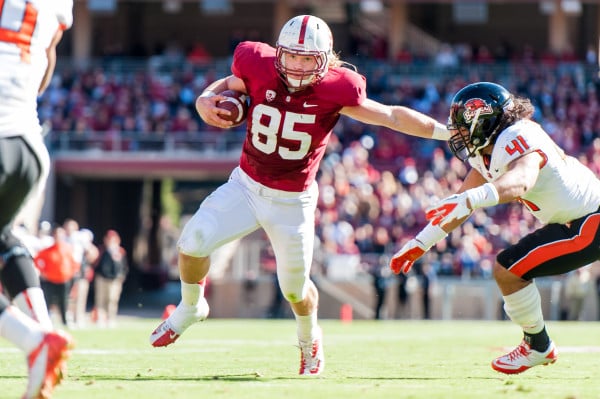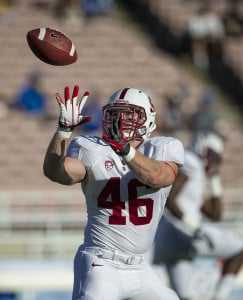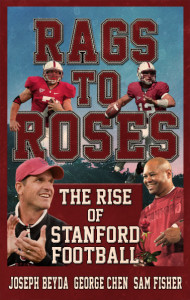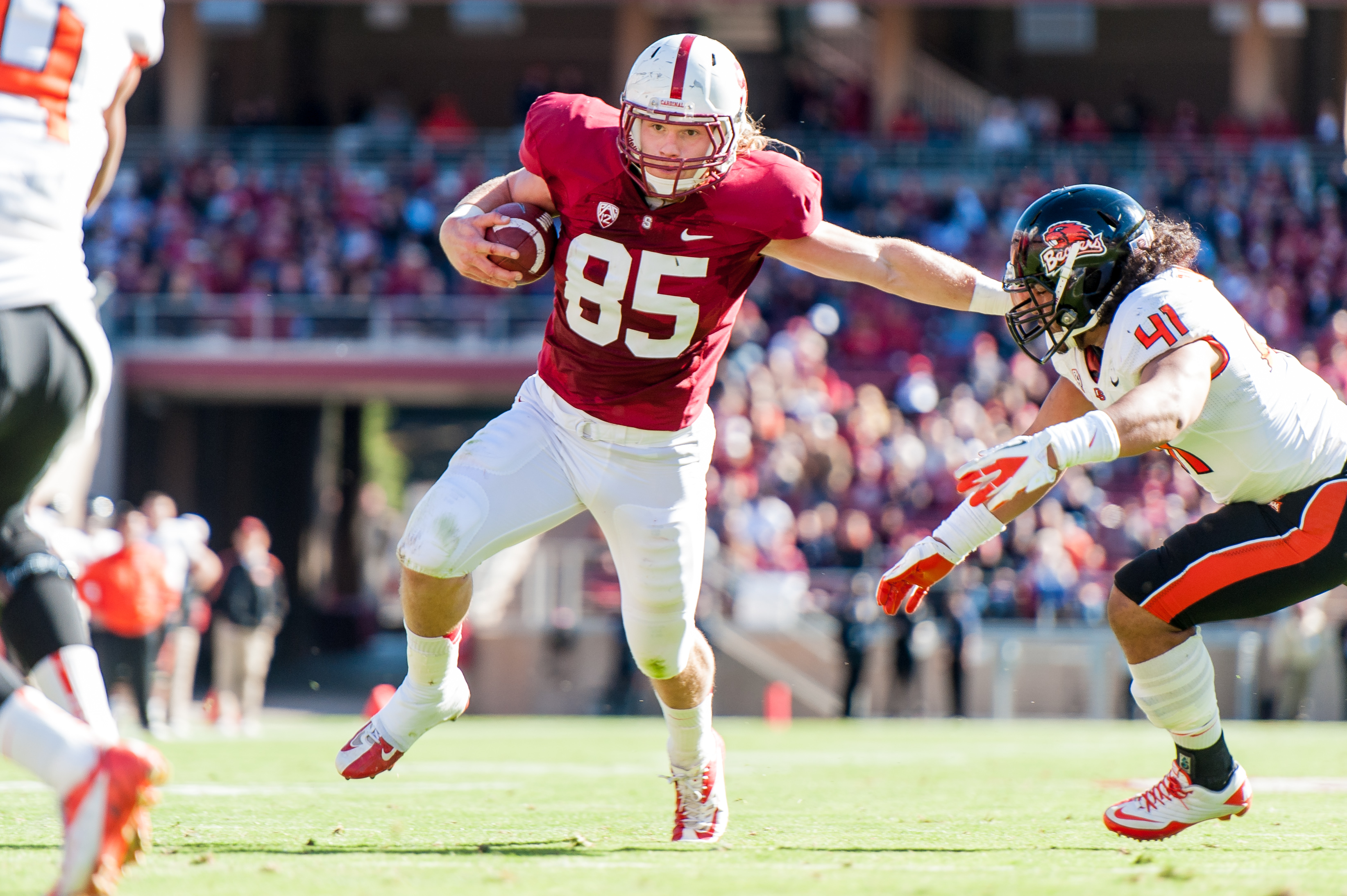Somewhere in Columbia, S.C., Jadeveon Clowney is celebrating his team’s 54-3 win against Kentucky.
Somewhere in Palo Alto, a golden helmet is rolling past the 25-yard line.
Score one for Geoff Meinken.
Having separated Colorado linebacker Douglass Rippy from his headgear, the Cardinal’s backup fullback pounds forward for an otherwise ordinary 3-yard gain. Three weeks ago, Meinken stiff-armed his way to a 40-yard run against Duke; this carry is just icing on the cake. Rippy’s helmet, after all, went twice as far as Meinken did.
But though the college football world might be impressed more by big defensive hits, like Clowney’s own helmet-cruncher in the 2013 Outback Bowl, than by physical fullback play, Stanford is a clear exception to the rule.

“We take a lot of pride in it,” said redshirt junior fullback Lee Ward. “We’re a smashmouth football team and we’re always going to stick to that.”
“Fullbacks are a special kind of breed,” added running backs coach Tavita Pritchard. “They’re special guys and I know their teammates really appreciate it, because they’re kind of the dirty workers. They go in there, they bang their heads against the wall for the betterment of the team.”
While most other Division I teams have moved away from the position entirely, Stanford has three fullbacks on its roster — and it plans to play all three of them.
“It’s kind of weird,” Ward said. “You watch other teams play and they rarely use a fullback, and when they do, it’s not great fullback play. But we’re lucky enough to have three guys who know how to play the position and play it well.”
As the season opener against San Jose State this Saturday approaches, that depth will be as crucial as ever. Fifth-year senior starter Ryan Hewitt missed practice this week with a bruised knee, and he might be held out of the team’s showdown with the Spartans for a second consecutive year. That would leave the fullback duties to Ward and redshirt sophomore Patrick Skov, whose brother, Shayne, is known for his physicality on the other side of the ball.
The only man missing from the equation is Meinken, who was forced to medically retire in April due to a knee injury.
“It sucked losing him,” Ward said. “He was a special athlete…He brought a lot of energy to the room.”
Skov has taken a big step this fall, especially in the weight room; running backs coach Tavita Pritchard recently described him as an “action figure.” But if anyone is fit to take the reins from Meinken, it’s Ward.
“When we’re talking about physical play at the fullback position, [Ward] is kind of where we hang our hat right now,” Pritchard said.

With the 6-foot-1, 245-pound Ward’s physicality comes the same mean streak that Meinken brought to the table two seasons ago.
“I was the kid in elementary school who was playing asphalt soccer and was still slide-tackling,” Ward said. “I think that kind of sums up my persona, even now on the football field… I’m a little more the true fullback type, where I’m just going to run inside the tackles, hit the crap out of someone — excuse the French — and drive them back and open up running lanes.”
Though Hewitt, when healthy, is the team’s starter, he is known more for his pass-catching abilities than his run-blocking. The versatile fifth-year senior lines up at fullback, tight end and even receiver, and he is the primary beneficiary of Stanford’s now-infamous Spider Y Banana plays.
But don’t be mistaken; Hewitt’s run-blocking is no liability. Head coach David Shaw called him “a different caliber athlete” on Wednesday, and Pritchard noted Hewitt’s familiarity with the coaching staff as another added bonus.
“Being here the longest, he’s the guy that’s built a tremendous amount of trust with the offensive staff,” Pritchard said. “There’s nothing we feel like he’s not able to do.”
Even though Pritchard claimed that Ward and Skov aren’t far behind, whether they can fill in for Hewitt seamlessly is another question. Without Hewitt, Stanford averaged just 3.7 yards per carry in its first two games of 2012. Though those struggles had a lot to do with the Cardinal’s reshuffled offensive line, Hewitt’s veteran presence was sorely missed as well.
Last season, however, Ward and Skov played in all 14 games, so Shaw said the coaches can afford to hold him out if it is necessitated by injury.
Three fullbacks should be more than enough for the time being, but there’s always a last resort for the Cardinal coaching staff: converting another player to the position. After all, Hewitt began his Stanford career at tight end before switching to fullback in 2010, filling in for two-way stud Owen Marecic when he used the spring session to focus on defense.
So which current Cardinal player has potential as a future fullback?
“There’s a guy on the D-line, I’ve kind of been in his ear a little bit about playing fullback. His name’s Alex Yazdi,” Ward said. “His nickname on the team is ‘The Iranian Meatball’…once he gets a head of steam, he’s hard to stop.”
“I was trying to get Ed [Reynolds] to come play fullback,” Pritchard mused as the star safety walked by.
“There’s a lot of guys who could do it,” Ward concluded, “but we have pretty good depth right now, especially with three. As you mentioned, that’s unheard of in college football.”
Contact Joseph Beyda at jbeyda “at” stanford.edu.
Previous installments in our 2013 football season preview:
Sept 1.: Richards and Reynolds anchor a deep Cardinal secondary
Aug. 28: Young Stanford receivers look to end two years of mediocrity
Aug. 26: Without Taylor, the Cardinal stable re-opens
Aug. 25: Anderson, Stanford defensive line look to wreak havoc once again
Aug. 20: Tarpley, Skov and Murphy headline Stanford’s elite linebacker corps
Aug. 19: Upstart tight ends look to fill void left by Ertz, Toilolo
Aug. 14: Hogan embraces leadership role, ready to take the next step
Aug. 13: Offensive line powers forward, seeks new center

